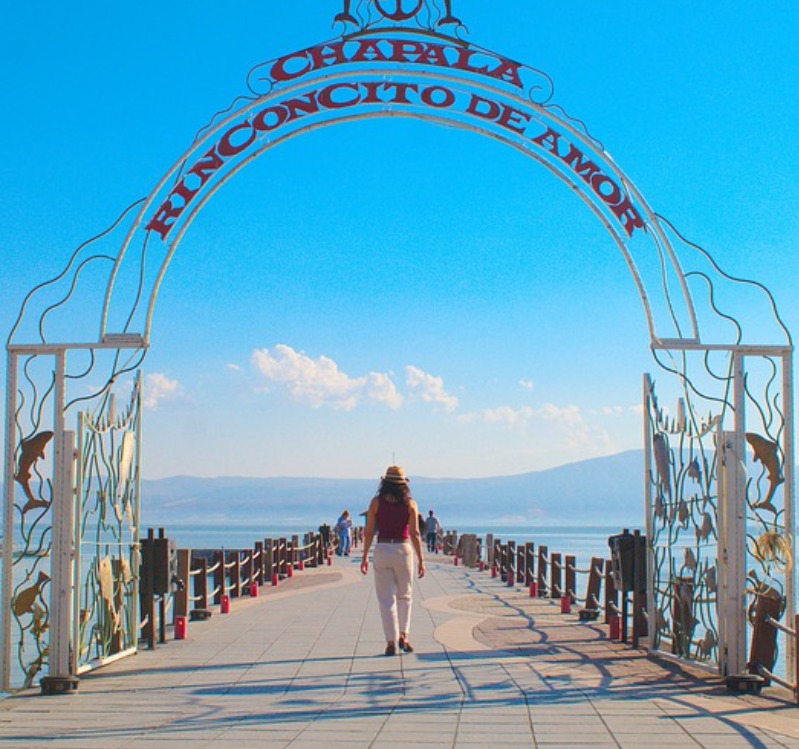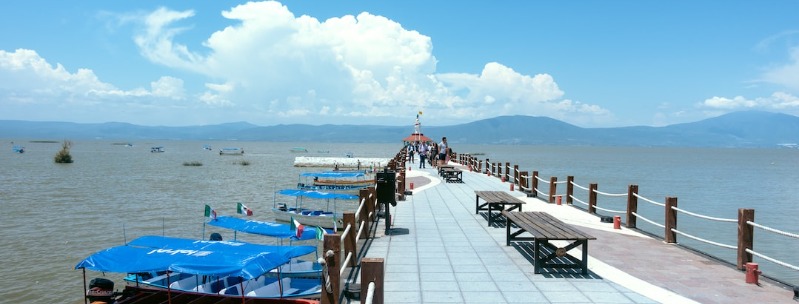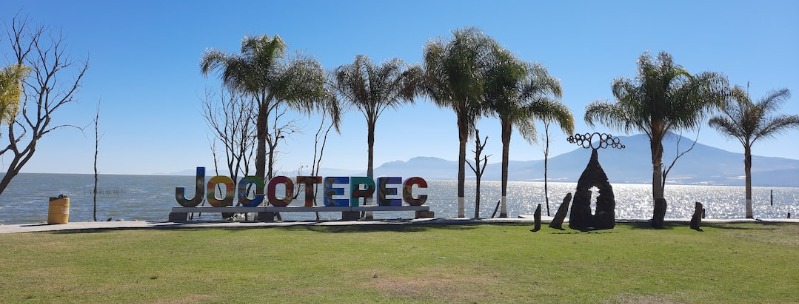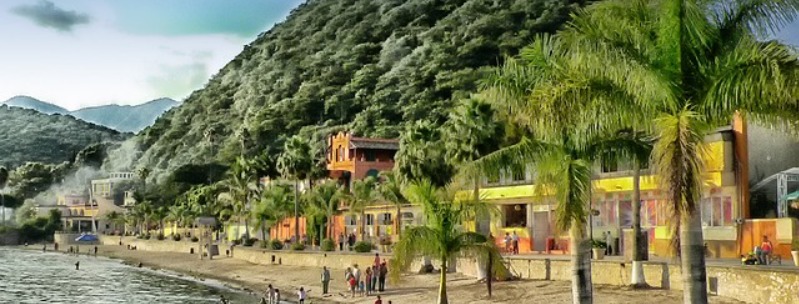Lake Chapala Travel Guide
Plan on a leisurely holiday of at least three or four days to fully enjoy the charm of the villages on the north shore, where burros trailed by a dusty farmer can still be seen carrying their loads through the narrow streets.
Chapala, the focal point of the north shore, was founded in 1538 by Father Miguel de Bolonia, who converted the area’s Coca Indians to Christianity. One of their chiefs was named Chapa, from which the name Chapala comes.
It’s interesting to stroll along the waterfront of Chapala. Beautiful views, well-maintained gardens, and handicraft stalls vie for your attention. Near the pier, you can spot boatmen with their colorful launches for rent.

Perhaps the best-known landmark on the waterfront is the Beer Garden, the largest restaurant bar along the lake. It celebrated its 70th birthday in 1999. On afternoons you can see colorful mariachis — guitar and trumpet musicians dressed like charros (Mexican cowboys) — paid for each piece they play. Adjoining the Beer Garden is the Nido, Chapala’s oldest and most central hotel.
There are several sidewalk cafes (Cafe Paris, Cafe Superior) near the center of town, serving as focal points for socializing as well as offering good breakfasts and a variety of tasty snacks.
The villa where British author D. H. Lawrence wrote his widely read “Plumed Serpent,” is Zaragoza 307. It is now a gorgeous small inn, Quinta Quetzalcoatl.
Local and Guadalajara sailors dock their sailboats and speedboats at the Chapala Yacht Club east of the pier. Across the street is the Artesanias Center with stalls offering everything from leather goods to hand-embroidered dresses and blouses, carved-wood items, toys, and a bewildering range of souvenirs. Down the street is Cristiania Park, with public tennis courts, a swimming pool and picnic areas.
The Chapala Country Club is about 15 minutes east of Chapala. A nine-hole, regulation par 36 golf course offers a relaxing afternoon. The clubhouse offers good light lunches and bar service. Tel. 763-5136.
The area around Lake Chapala, one of Mexico’s largest natural lakes, has one of the finest climates in the world. People from countless countries have chosen to retire here and enjoy the warm days and cool nights along the shores of this 55-mile-long body of water.
According to historians, the first American came to the area in 1885, but it wasn’t until 1955 that the larger influx of foreigners began. Now it is estimated that more than 6,000 foreigners, mostly Americans and Canadians, live on the north shore. The area has grown to be one of the most popular retirement colonies in North America.
An excellent four-lane highway connects Chapala to Guadalajara, less than 40 minutes away. From the airport to Chapala it is only 25 minutes. There are many bonded guides and taxi drivers who take visitors to the lakeside.
San Antonio Tlayacapan
On the western shore is the sleepy little village of San Antonio Tlayacapan, right out of a storybook with its church, town square, and cobblestone streets. It is here that Dane Chandos (actually the pen name of two British authors) wrote the charming book “Village in the Sun,” which brought many people to the area.
A more modern work affording insight into this region of Mexico is Tony Burton’s “Western Mexico-A Traveller’s Treasury” (Editorial Agata, 1994). Now based in Canada, Burton has been running excellent personalized tours to see the monarch butterflies and other west Mexico attractions each year since 1981. Tel. (250) 245-0772. E-mail: [email protected].
Ajijic, MX
The town of Ajijic, with its delightful hiccuping sound (ah-hee-HEEK), was founded by Nahua Indians under their chief, Xitomatl, in the early 1400s. The town’s San Andres Church, as well as its little chapel, Virgen de Santiago, date to the 1500s, though the church was rebuilt in 1749. Ajijic’s cobblestone streets were laid during the days of Spanish rule.
Tucked behind many of the crumbling walls are the upscale homes of interesting foreigners. But not even the “gringo” invasion has done much to alter the tempo of Ajijic. The Mexicans who live here have managed to maintain their customs and ways.

The Lake Chapala Society, an organization with the largest membership of expatriates in Jalisco, is at 16 de Septiembre 116-A. The society, which is run by volunteers, has a beautiful garden and one of the most extensive English-language and video-lending libraries in Mexico. There are more than 40 charitable and social groups in the Chapala area.
By far the best hotel in downtown Ajijic is La Nueva Posada, at Donato Guerra 9 (766-1444), with gardens extending down to the lake shore. The Eager family is exceptionally cordial hosts with years of experience in the hotel and restaurant business. Built in Spanish colonial style, La Nueva Posada offers 19 luxurious rooms and suites, a guests-only swimming pool, dining areas both indoors and outdoors under the extended branches of a gigantic rubber tree, and live entertainment most evenings. The immaculately landscaped grounds afford an excellent view of the lake.
Recommended real estate agencies in the Lake Chapala area include Century 21 Vistas Realty (tel. 766-2612), Laguna Real Estate (tel. 766-1174), and Ajijic Developments, tel. 766-2103.
Shops near Lake Chapala
On the highway at Riberas del Pilar is The Duke Conglomeration. Designer Ted Duke manufactures and sells (wholesale and retail) fine hand-crafted wrought iron, pottery, glass, and tin decorative items for high-end furniture stores in the United States. Tel. 765-3353.
At Independencia 9-A is La Coleccion barbara (with a small “b”), easily the best antique shop for miles around. Owner Tom Thompson is an authority on Oriental rugs. All kinds of marvelous objects fill this store, including century-old examples of Mexican folk art. Tel. 766-1824.
CABA, at Colon 43, is a fine arts center run by a cooperative of local artists, some of whom have international reputations. After viewing the dozens of unusual and intriguing works of art, enjoy a refreshing drink or snack in their garden restaurant. At CABA you can also sign up for cultural tours of the region, including a countryside hacienda tour, a nightlife tour of Guadalajara, and a handicrafts tour of Michoacan. Tel. 766-1920.
Across the street, at Morelos 15, is the charmingly decorated Opus Boutique y Galeria. It features fine clothing designed by Diana Martin, as well as the Opus and Tipicano lines, and a wide selection of designer and ethnic jewelry, including creations by Donna Browne and Argentinean Louisa Conti. Other rooms in this attractive colonial building are used to display Mexican folk art. This is a fun place to explore and find unusual gift items. Lois Cugini, the proprietor, is always on hand to offer assistance.
At 16 de Septiembre 4 is Centro Artesanal La Vieja Posada, housed in part of a former tequila-making hacienda that dates back 146 years. You’ll find selected arts and crafts from all over Mexico, as well as delicately hand-painted colonial-style furniture and cool cotton clothing, wholesale or retail.
West of Morelos, at Ocampo 30, is Galeria Daniel Palma. Palma, who was born in Ajijic, is gaining international renown for his wonderfully powerful kinetic animal sculptures made by combining natural stone, wood, and iron. Tel. 766-1688.
A few doors away, at Ocampo 33, is Ferriolo, with beautiful village-made hand-loomed bedspreads, tapestries, pillowcases, and a variety of textile-based gift items. You can watch the weaving process at their workshop at Ocampo 20. Tel. 766-1860.
At Rio Zula 4, behind the Danza del Sol hotel, is the factory showroom of the internationally recognized American designer Billy Moon. Galeria Moon consists of home decorations that combine ceramics with iron, wood, and hand-blown glass. All items in the collection have a weathered or textured finish. Prices are very reasonable. Tel. 766-1000.
Lake Chapala Restaurants
In the gardens of Galeria Moon (Rio Zula 4) is A La Luz de La Luna, an upscale restaurant bar with a great atmosphere. Tel. 766-2092.
Posada Ajijic, on the lake shore, beside the pier, is a longtime Ajijic fixture. This restaurant bar offers Mexican cuisine, live music and dancing several nights a week, and a Sunday champagne brunch served in the garden. Here, Javier Mercado is your friendly host.
Many people’s favorite place to dine out is La Nueva Posada, also on the lake shore, at Donato Guerra 9. Indoors or out, both food and service at this hotel described more fully above, are always reliably excellent.
One block up from the pier, at Morelos 6, is Los Telares restaurant (766-0428), also with indoor and outdoor dining. Los Telares prides itself on its meat and seafood dishes in a mix of traditional and nouvelle cuisine.
You can have teppanyaki specialties prepared at your table at Ajijic Grill, a Japanese steak house and sushi bar at Morelos 5. Tel. 766-2458.
In Haciendas Ajijic is Bing’s Ice Cream Parlor, one of a chain of ice-cream outlets founded by a retired U.S. Consul General living in Guadalajara. All their delicious flavors are made with natural ingredients.
In Danza del Sol is Armando’s restaurant-bar (766-2229). As his regular patrons will testify, Armando’s international cooking is hard to beat.
If you are in the mood for Italian, Trattoria de La Floresta (766-1192) offers traditional favorites in an elegant setting with piano music.
Above the highway, at Galeana 75, with an excellent view over the lake, is Montecasino (766-1747), a restaurant bar specializing in Mexican home cooking. Doña Teresa’s menu is limited but the food is good and the prices are very reasonable. Open 9 a.m. to 9 p.m.
Also north of the highway, in Upper Ajijic, at Tepalo 96-A, is Min Wah, an outstanding Chinese restaurant where owners Martha and Alvaro Beas have set themselves high standards — and kept them! Open 11 a.m. to 8 p.m. daily. Live music Thursday to Saturday nights. Tel. 766-0686.
Across from the auditorium, at Ajijic 118, is Johanna’s, an authentic German restaurant. Tel. 766-0437.
San Juan Cosala, Jocotepec
Ten minutes west of Ajijic is the small village of San Juan Cosala and its spa, famous for its thermal baths and spouting geyser. The Balnearios motel occupies the lakefront. On the highway are the Villas Buenaventura, comfortable condominiums with private thermal pools that may be rented by the hour, day or week.
Jocotepec is the village at the extreme western end of the lake. Its history traces back to 1361, when the Nahua Indians settled there. In 1520 a Spanish expedition led by a cousin of Hernan Cortes conquered the Indians, and in 1529 Jocotepec was founded.

In years past, Jocotepec was a stopping place on the fifth day of the stagecoach journey from Mexico City to Guadalajara.
Jocotepec has rustic charm and is widely known for its beautifully woven serapes with traditional flower motifs. There are good selections of serapes and other local handicrafts at Artesanias Rodriguez (Hidalgo Sur 66).
Hidden away at Juarez Pte. 79 is the Villaseñor woodcarving workshop (763-0398). This family specializes in producing high-quality carved doors, columns, saints, and archangels, all on a pre-commissioned basis.
At Hidalgo Sur 71 is La Carreta restaurant, which serves freshly-prepared Mexican home-style barbecues on the patio of an ancient colonial building.
Only limited accommodation is available in Jocotepec but professional artists Georg and Phyllis Rauch welcome discerning bed-and-breakfast travelers to their mountainside home and studio which overlooks the town and lake. Los Dos B&B offers two suites and a three-level cottage in addition to the hospitality and regional insights of the Rauchs, who have lived in Mexico for more than 20 years. Tel. 763-0657.
